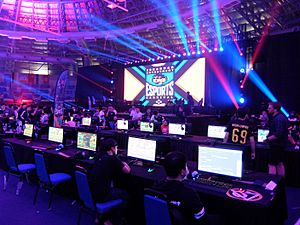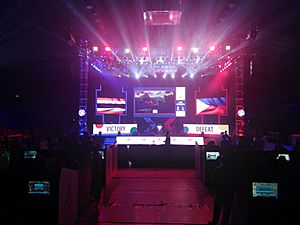Electronic sports facts for kids
Electronic sports is the term for video games that are played competitively. Popular electronic sports games are Counter-Strike, League of Legends, Warcraft, Starcraft, Dota 2, and Quake. Electronic Sports is played over the Internet or via LAN. There are professional leagues and tournaments like the Cyberathlete Professional League, ClanBase, Electronic Sports League and the World Cyber Games where electronic sports players can earn thousands of US Dollars. One example is Starcraft in Korea where they have many players who are very competitive. E-sports has been around since the dawn of arcades when players would battle it out for number one.
According to TechCrunch the game maker Epic Games is providing $100 million in prize money in 2019 for participants in esports.
Contents
Classification as a sport
Labeling competitive video games as a sport is a controversial topic. Proponents argue that esports are a fast-growing "non-traditional sport" which requires "careful planning, precise timing, and skillful execution". Others claim that sports involve physical fitness and physical training, and prefer to classify esports as a mind sport.
Former ESPN president John Skipper described esports in 2014 as a competition and "not a sport".
Russia was the first country that classified "cybersport" as an official sport discipline on 25 July 2001.
China was another one of the first countries to recognize esports as a real sport in 2003. Furthermore, by early 2019, China recognized esports players as an official profession.
History
The earliest known video game competition took place on 19 October 1972 at Stanford University for the game Spacewar. Stanford students were invited to an "Intergalactic spacewar olympics" whose grand prize was a year's subscription for Rolling Stone, with Bruce Baumgart winning the five-man-free-for-all tournament and Tovar and Robert E. Maas winning the team competition.
Contemporary esports has roots in competitive face-to-face arcade video game competitions. A forerunner of esports was held by Sega in 1974, the All Japan TV Game Championships, a nationwide arcade video game tournament in Japan. The tournament was intended by Sega to promote the play and sales of video games in the country. There were local tournaments held in 300 locations across Japan, and then sixteen finalists from across the country competed in the final elimination rounds at Tokyo's Hotel Pacific. Prizes awarded included television sets (color and black-and-white), cassette tape recorders and transistor radios. According to Sega, the tournament "proved to be the biggest event ever" in the arcade game industry, and was attended by members from leading Japanese newspapers and leisure industry companies.
The golden age of arcade video games was heralded by Taito's Space Invaders in 1978, which popularized the use of a persistent high score for all players. The Space Invaders Championship held by Atari in 1980 was the earliest large scale video game competition, attracting more than 10,000 participants across the United States, establishing competitive gaming as a mainstream hobby. It was won by Rebecca Heineman.
In 1984, Konami and Centuri jointly held an international Track & Field arcade game competition that drew more than a million players from across Japan and North America. Play Meter in 1984 called it "the coin-op event of the year" and an "event on a scale never before achieved in the industry". As of 2016[update], it holds the record for the largest organized video game competition of all time, according to Guinness World Records.
The fighting game Street Fighter II (1991) popularized the concept of direct, tournament-level competition between two players. Previously, video games most often relied on high scores to determine the best player, but this changed with Street Fighter II, where players would instead challenge each other directly, "face-to-face", to determine the best player, paving the way for the competitive multiplayer and deathmatch modes found in modern action games. The popularity of fighting games such as Street Fighter and Marvel vs. Capcom in the 1990s led to the foundation of the international Evolution Championship Series (EVO) esports tournament in 1996.
Large esports tournaments in the 1990s include the 1990 Nintendo World Championships, which toured across the United States, and held its finals at Universal Studios Hollywood in California. Nintendo held a 2nd World Championships in 1994 for the Super Nintendo Entertainment System called the Nintendo PowerFest '94. There were 132 finalists that played in the finals in San Diego, California. Mike Iarossi took home 1st prize.
During the 2010s, esports grew tremendously, incurring a large increase in both viewership and prize money. Although large tournaments were founded before the 21st century, the number and scope of tournaments has increased significantly, going from about 10 tournaments in 2000 to about 260 in 2010. Many successful tournaments were founded during this period, including the World Cyber Games, the Intel Extreme Masters, and Major League Gaming.
The modern esports boom has seen a rise in video games companies embracing the esports potential of their products. After many years of ignoring and at times suppressing the esports scene, Nintendo hosted Wii Games Summer 2010. Spanning over a month, the tournament had over 400,000 participants, making it the largest and most expansive tournament in the company's history. In 2014 Nintendo hosted an invitational Super Smash Bros. for Wii U competitive tournament at the 2014 Electronic Entertainment Expo (E3) press conference that was streamed online on Twitch. Halo developers 343 Industries announced in 2014 plans to revive Halo as an esport with the creation of the Halo Championship Series and a prize pool of US$50,000. Both Blizzard Entertainment and Riot Games have their own collegiate outreach programs with their North American Collegiate Championship. Since 2013 universities and colleges in the United States such as Robert Morris University Illinois and the University of Pikeville have recognized esports players as varsity level athletes and offer athletic scholarships. In 2017, Tespa, Blizzard Entertainment's collegiate esports division, unveiled its new initiative to provide scholarships and prizes for collegiate esports clubs competing in its tournaments worth US$1 million. Colleges have begun granting scholarships to students who qualify to play esports professionally for the school. Colleges such as Columbia College, Robert Morris University, and Indiana Institute of Technology have taken part in this. In 2018, Harrisburg University of Science and Technology began a tuition scholarship program for esports players.
In 2014, the largest independent esports league, Electronic Sports League, partnered with the local brand Japan Competitive Gaming to try and grow esports in the country.
Physical viewership of esports competitions and the scope of events have increased in tandem with the growth of online viewership. In 2013, the Season 3 League of Legends World Championship was held in a sold-out Staples Center. The 2014 League of Legends World Championship in Seoul, South Korea, had over 40,000 fans in attendance and featured the band Imagine Dragons, and opening and closing ceremonies in addition to the competition.
In 2015, the first Esports Arena was launched in Santa Ana, California, as the United States' first dedicated esports facility.
Olympic Games recognition
The Olympic Games are also seen as a potential method to legitimize esports.
In January 2022, the IOC announced the appointment of the organisation's first ever head of virtual sport, tasked with the development of virtual sport for the global Olympic body, increasing the organisation's engagement with gaming communities, and overseeing the Olympic Virtual Series, IOC's first licensed non-physical sports event. The inaugural series included virtual baseball, cycling, rowing, esailing and motorsports events.
In February 2022, the Commonwealth Games Federation announced that esports would be included in the 2022 Commonwealth Games as a pilot event, with the possibility of it being a medal event in the 2026 Games. The inaugural Commonwealth Esports Championship had separate branding, medals, and organisation and included both men and women's Dota 2, eFootball, and Rocket League events.
As a follow-up to 2021's Olympic Virtual Series, the IOC and the Singapore National Olympic Council held the inaugural Olympic Esports Week in Singapore in June 2023. Games featured at the event included:
- Tic Tac Bow (archery)
- WBSC eBaseball: Power Pros (baseball)
- Chess.com (chess)
- Zwift (cycling)
- Just Dance (dancing)
- Gran Turismo (motor sport)
- Virtual Regatta (esailing)
- Fortnite (sharpshooting)
- Virtual Taekwondo (taekwondo)
- Tennis Clash (tennis)
Health concerns
Most esports generally require participants to sit and/or move little while playing, which raises concerns about a sedentary lifestyle by players. A research led by Ingo Froböse, a professor at the German Sports University in Cologne, for over eight years found professional and also amateur esports gamers play on average 24–25 hours per week and even physical activities after hours of playing are not able to compensate the damage of oversitting. Players in China may train for almost 14 hours a day. A study conducted in 2022 of CS:GO players found that total hours played were about 31.2 hours each week. Sitting for long periods at a computer could lead to eye fatigue and lower back pain from poor posture. Gamers with poor posture sit in forward head posture which can cause symptoms such as decreased arm or shoulder mobility and tension headaches. These sedentary behaviors of sitting for too long concerns public health researchers because spending more than 6–8 hours per day has been linked to increased risk of cardiovascular disease and all-cause mortality. As a result, teams like T1 have partnered with Nike to encourage exercise and provide training that helps improve gaming skills.
In addition to sedentary behaviors, players' mental health is a concern for scientists. One study found that competitors in esports are often under psychological and physical stress, and the amateur ones are the most affected, since they frequently aim at greater wins without enough preparation, though no clear training guidelines are set to become professional players. Researchers have found that high levels of stress lead to mental illness and poor decision making. The Esports sector has a high rate of burnout due to mental health and stress. A study found a correlation between depression and training time leading to sleep disturbances. Teams are starting to incorporate mental health support for players. Misfits has hired a psychologist to ensure players are equipped with methods to deal with stress and anxiety.
Images for kids
-
Players competing in a League of Legends tournament
-
Attendees of the 1981 Space Invaders Championships attempt to set the highest score
-
The League of Legends World Championship is an annual League of Legends tournament that rotates its venues around the world.
See also
 In Spanish: Deportes electrónicos para niños
In Spanish: Deportes electrónicos para niños









